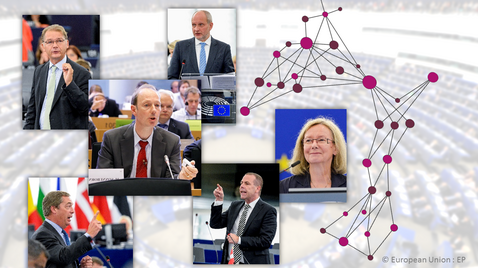A network analytical take on the European Parliament
Video:

- Sponsored by: TUM Professur für Computational Social Science and Big Data
- Scientific Lead: Dr. Mirco Schönfeld
- Co-Mentor: PhD candidate Laure Vuaille
- Project Lead: Dr. Ricardo Acevedo Cabra
- Term: Winter semester 2018
Analyzing texts with network-analytical methods facilitates insights into inherent complex structure of stories, arguments, opinions, or topics. Some forms of texts even allow mapping identified structures onto humans revealing a contextualized social network with stories, arguments, opinions, or topics as valuable annotations. These annotations can then be incorporated into deeper analysis of the social network. An area of interest for this kind of approach is international politics.
International politics is a system of political actors representing and expressing interests of nations and international organisations through official, long-prepared statements. As such, statements communicate point-of-views and opinions of individuals, their parties, their organisations, or even their nations. Since such official communication is often persistently available as text data, it is possible to apply the above-mentioned network-analytical approach to such corpora. This enables analysis of political systems in terms of collaborators, influencers, hidden agendas, and coalitions.
Further, official statements often contain temporal information as well, i.e. statements are published on one event of an ongoing series of events. Considering such temporal aspects for the above-mentioned analysis, it is even possible to illuminate evolutionary development of collaborations and coalitions.
This project is about conducting such a network-analytical approach on the European Parliament. The text-corpus of interest is the publicly available set of transcribed speeches of parliamentary debates. In order to apply and combine machine learning approaches and network-analytical methods, we get to know necessary techniques first. This includes topic modelling and comparison as well as advanced network analysis. We will then find ways to combine these methods beneficially. Very importantly, this includes dealing with multilingual nature of our data source.
Results: The results of this project are explained in detail in the final documentation and presentation.